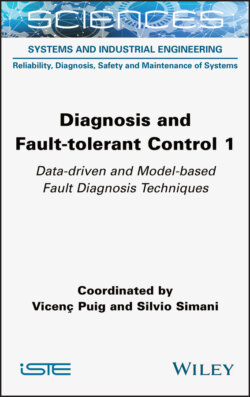Читать книгу Diagnosis and Fault-tolerant Control 1 - Группа авторов - Страница 11
I.1. Introduction
ОглавлениеThere is an increasing interest in the theory and applications of model-based fault detection and fault diagnosis methods, because of economical and safety-related matters. In particular, well-established theoretical developments can be seen in many contributions published in the IFAC (International Federation of Automatic Control) Congresses and IFAC Symposium SAFEPROCESS (Fault Detection, Supervision and Safety of Technical Processes) since the seminal editions (Isermann and Ballé 1997; Isermann 1997; Patton 1999; Frank et al. 2000).
The developments began at various places in the early 1970s. Beard (1971) and Jones (1973) reported, for example, the well-known “failure detection filter” approach for linear systems.
A summary of this early development is given by Willsky (1976). Then, Rault et al. (1971) considered the application of identification methods to the fault detection of jet engines. Correlation methods were applied to leak detection (Siebert and Isermann 1976).
The first book on model-based methods for fault detection and diagnosis with specific application to chemical processes was published by Himmelblau (1978). Sensor failure detection based on the inherent analytical redundancy of multiple observers was shown by Clark (1978).
The use of parameter estimation techniques for fault detection of technical systems was demonstrated by Hohmann (1977), Bakiotis et al. (1979), Geiger (1982) and Filbert and Metzger (1982).
The development of process fault detection methods based on modeling, parameter and state estimation was then summarized by Isermann (1984, 1997).
Parity equation-based methods were developed initially by Chow and Willsky (1984) and then further developed by Patton and Chen (1994), Gertler (1991) and Höfling and Pfeufer (1994).
Frequency domain methods are typically applied when the effects of faults as well as disturbances have frequency characteristics that differ from each other and thus the frequency spectra serve as criterion to distinguish the faults (Massoumnia et al. 1989; Ding and Frank 1990; Ding et al. 2000; Frank et al. 2000).
The developments of fault detection and isolation (FDI) methods to the present time are summarized in books by Pau (1981), Patton et al. (2000), Basseville and Nikiforov (1993), Chen and Patton (1999), Gertler (1998) and Isermann (1994b) as well as in survey papers by Gertler (1988), Frank (1990) and Isermann (1994a).
Within IFAC, the increasing interest in this field was taken into account by creating first in 1991 a SAFEPROCESS (Fault Detection Supervision and Safety for Technical Processes) Steering Committee, which then became a Technical Committee in 1993. The first IFAC SAFEPROCESS Symposium was held in Baden–Baden (Germany) in 1991 (Isermann and Freyermuth 1992). The last edition was organized in 2018 in Warsaw (Poland). Another triennial series of IFAC workshops exist for “Fault detection and supervision in the chemical process industries”. Many other thematic workshops have been organized between 1992 and 2020.
Most contributions in fault diagnosis rely on the analytical redundancy principle. The basic idea consists of using an accurate model of the system to mimic the real process behavior. If a fault occurs, the residual signal (i.e. the difference between the real system and model behavior) can be used to diagnose and isolate the malfunction.
Model-based method reliability, which also includes false alarm rejection, is strictly related to the “quality” of the model and measurements exploited for fault diagnosis, as model uncertainty and noisy data can prevent an effective application of analytical redundancy methods.
This is not a simple problem, because model-based fault diagnosis methods are designed to detect any discrepancy between the real system and model behaviors. It is assumed that this discrepancy signal is related to (has a response from) a fault. However, the same difference signal can respond to model mismatch or noise in real measurements, which are erroneously detected as a fault. These considerations have led to research in the field of “robust” methods, in which particular attention is paid to the discrimination between actual faults and errors due to model mismatch.
However, the availability of a “good” model of the monitored system can significantly improve the performance of diagnostic tools, minimizing the probability of false alarms.
This book explains what a good model is, one that is suitable for robust diagnosis of system performance and operation. The book also explains how robust models can be obtained from real data. A large amount of attention is paid to the “real system modeling problem”, with reference to either linear or nonlinear model structures. Special treatment is given to the case in which noise affects the acquired data. The mathematical description of the monitored system is obtained by means of a system identification scheme based on equation error and errors-in-variables models. This is an identification approach that leads to a reliable model of the plant under investigation, as well as the estimation of the variances of the input–output noises affecting the data.
The purpose of this book is also to provide guidelines for the modeling and identification of real processes for fault diagnosis and fault-tolerant control (FTC). Hence, significant attention is paid to the practical application of the methods describing real system studies, as reported in the last chapters of Volume 2.
In particular, this introduction of the book outlines a new common terminology in the fault diagnosis framework and provides some discussion and a summary of developments in the field of fault detection and diagnosis as well as FTC based on papers selected during 1991–2020.
